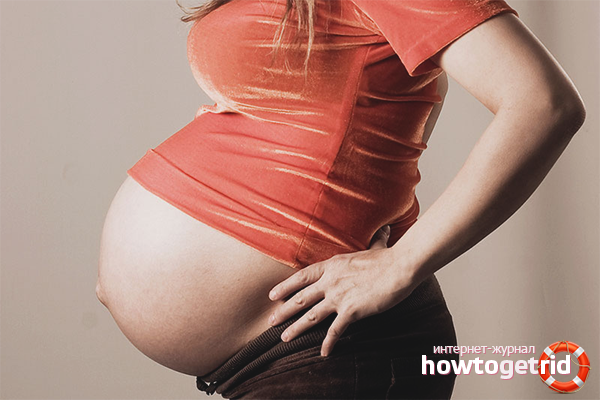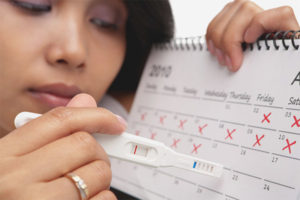The content of the article
The body is a complete and autonomous system that can work wonders. One of these miracles is conception and pregnancy. In just nine months, the combination of the mother’s microscopic egg and the father’s even smaller sperm becomes a real and full-fledged person who begins a new life.
A placenta is attached to the posterior wall of the uterus, which is connected through the umbilical cord to the baby. She gives the baby food, removes waste products from his body. Between the placental membrane and the baby himself is an amniotic fluid. It consists of a huge number of vitamins, acids, hormones, trace elements, urea, sugar, antigens and other components, each of which performs its important function. Amniotic fluid changes in quantity depending on the period. If at a certain stage of pregnancy the fluid becomes too much, polyhydramnios is diagnosed. This is a dangerous condition that can lead to serious consequences, both in relation to the mother and the fetus. In this article, you will learn what functions amniotic fluid performs, which leads to an increase in its amount, what consequences polyhydramnios can bring, and also how to deal with it.
What is amniotic fluid needed for?
Each organ of the human body has a specific purpose. Amniotic fluid plays a very important role in a healthy pregnancy. Consider what basic functions it performs.
- Amniotic fluid creates favorable conditions for the movement of the child. The kid can calmly move his legs and arms, nothing squeezes him, there are no obstacles. A small amount of amniotic fluid can lead to the fact that the fetus develops various pathologies and deformities, usually in the extremities.
- Amniotic fluid protects the baby from external negative factors. Even a blow with a drop in average strength is softened many times, precisely due to amniotic fluid.
- Amniotic fluid protects the umbilical cord from being squeezed. In water, the umbilical cord simply moves and is very difficult to transmit. And the closure of the umbilical cord is a very serious pathology - the baby is deprived of food, oxygen, etc.
- Amniotic fluid plays a crucial role during childbirth. They help the cervix to open. Women who have completely diverted water long before the birth process, give birth is much more difficult.
- Amniotic fluid protects the baby from loud sounds.
- The water contains nutrients that the baby absorbs in the skin during early pregnancy. In the later stages, the child often swallows amniotic fluid - it is absolutely safe and even useful.
- Amniotic fluid creates favorable conditions for the life of crumbs - a certain temperature and pressure.
- If the mother gets sick, even a serious infection, amniotic fluid creates a kind of barrier to protect the baby. In 80% of cases, the baby is not infected.
Now it becomes clear that amniotic fluid is a very important component of bearing a healthy pregnancy. But why is this fluid getting a lot? How to recognize polyhydramnios?
Symptoms of polyhydramnios
Polyhydramnios during pregnancy is usually diagnosed by a doctor - a woman does not feel any changes in the body or connect them with the general course of pregnancy. However, if you listen to yourself, polyhydramnios can still be suspected for some symptoms.
Firstly, the abdomen begins to ache unusually, discomfort and heaviness appear. The woman’s condition becomes unstable - she quickly gets tired, feels weak, and feels bad. The legs swell unusually strongly, the pulse quickens even with a slight load, shortness of breath appears. This is due to the fact that a large amount of amniotic fluid exerts severe pressure on the diaphragm. The first thing a doctor does with a suspicion of polyhydramnios is that he measures the circumference of the abdomen. If the circumference is more than 110 cm, the pregnant woman must be sent for ultrasound examination - the final diagnosis is made precisely by its results.
Polyhydramnios can be either chronic or acute. Chronic polyhydramnios is observed during the entire pregnancy - the total amount of amniotic fluid exceeds the norm. Acute polyhydramnios, which can develop in a few hours or days, is much more dangerous. At the same time, the pregnant belly is growing rapidly, serious striae (stretch marks) appear due to excessive stretching of the epidermis. Sometimes, inside the abdomen, a woman may feel gurgling - this also indicates polyhydramnios. Often with this diagnosis, the lower back hurts more than usual, the uterus is in good shape. With polyhydramnios, listening to the fetal heartbeat can be difficult. But how to protect yourself from this condition? Why does polyhydramnios appear?
Reasons for the development of polyhydramnios
In general, there is no direct provoking factor for polyhydramnios. In every third woman, doctors cannot find the cause of this condition. However, there are some diagnoses in which the risk of developing polyhydramnios increases.
- Infectious diseases of the mother.
- Type 1 or type 2 diabetes.
- Various pathologies of fetal development.
- Infection of an organism caused by a virus or bacterium.
- Some diseases of the cardiovascular system.
- Pregnancy with two or more fetuses. Moreover, if the twins are heterogeneous, multiple pregnancy can develop in only one child.
- Disorders of the renal system.
- Polyhydramnios often occurs if the fruit is large.
- If the mother and child have different Rh factors, a conflict may arise, against the background of which polyhydramnios develops.
- Normally, a child in the later stages swallows a certain amount of amniotic fluid. If this does not happen with any violations, polyhydramnios develops.
If you have a chronic disease, during pregnancy you need to be as attentive to your body as possible and consult a doctor for any changes in your well-being. After all, not always feeling unwell, tired, back pain and swelling of the legs - these are symptoms of a healthy pregnancy. Sometimes these signs can talk about something more serious. But what is the danger of polyhydramnios?
Consequences of polyhydramnios during pregnancy
To determine possible risks, you need to know the period for which polyhydramnios develops, as well as the intensity of the pathological process. Moderate polyhydramnios in late pregnancy is the least dangerous than acute polyhydramnios in the first trimester of pregnancy. So, what are the consequences of polyhydramnios?
- Polyhydramnios can provoke vomiting, poor health, and even loss of consciousness.
- Many expectant mothers with acute polyhydramnios may have a miscarriage or premature birth. In the third trimester, the baby can be saved - the child is already ready for life outside the mother’s womb. At the initial stages of pregnancy, high polyhydramnios, unfortunately, provokes the death of the child.
- With polyhydramnios, early discharge of water often occurs, which leads to the onset of labor.
- If there is a lot of amniotic fluid, the baby moves easily, turns over. This is fraught with the risk of entangling the umbilical cord. In addition, the child may take the wrong position - pelvic or lateral presentation.
- One of the consequences of polyhydramnios is the development of placental insufficiency. Because of this, fetal hypoxia develops, FPI can lead to the death of the baby.
- A large amount of amniotic fluid can lead to problems with the baby's health in the future. As a rule, these are diseases of the central nervous system and gastrointestinal tract.
- Amniotic fluid protects the fetus from maternal infection, but not 100%. If polyhydramnios develops due to infection, it can lead to infection of the fetus.
- Polyhydramnios can cause bleeding.
- Very often with polyhydramnios, gestosis develops - a complication in which cramps and swelling appear, pressure rises.
- Due to improper presentation of the fetus, polyhydramnios can cause delivery to take place by caesarean section.
- Polyhydramnios in late pregnancy can lead to a weakening of uterine contractions, which complicates the process of labor. In addition, polyhydramnios can cause premature placental abruption, intense bleeding after childbirth.
As you can see, polyhydramnios is a serious pathology that can harm both the child and the mother. Therefore, this diagnosis is considered a serious reason for treatment in a hospital. But what measures should be taken to treat polyhydramnios?
What to do with polyhydramnios
The most important thing in the treatment of pathology is to find out the cause of its development. If polyhydramnios is caused by an infectious disease, acceptable medicines are used against the identified pathogen. With bacterial infection, antibiotic therapy is used. When choosing a drug, preference is given to those drugs that are safe during pregnancy. If, during polyhydramnios, the fetus suffers from hypoxia, medications are prescribed to improve blood circulation in the blood vessels. They allow you to save the child from oxygen starvation and improve the utero-placental blood flow.
When diagnosing polyhydramnios, a woman should be kept in order to be under the supervision of doctors all the time. She must be prescribed B vitamins and diuretics. They allow you to get rid of edema and excess fluid in the body. Constant monitoring of the condition of a pregnant woman allows you to bring the pregnancy to its logical conclusion. In rare cases, when the threat to the mother is very high, doctors are forced to terminate the pregnancy artificially. If there is a threat to the baby, then after the 35th week of pregnancy you can provoke the birth process - babies of this period are quite viable. In very difficult cases, the question of puncture of amniotic fluid is resolved - but in this case there is a risk to the health of the mother and child, therefore this method of treatment is used extremely rarely.
To prevent polyhydramnios during pregnancy, it is necessary to timely comply with all the recommendations of the attending physician - drink vitamins, take tests, conduct an ultrasound scan, do a fetal dopplerography. These measures will allow you to identify various disorders (if any) in the early stages of fetal development. You also need to move more and control the amount of fluid you drink. Remember, regular medical examination is not a whim, but a vital necessity for you and your child.
Video: polyhydramnios during pregnancy












Submit